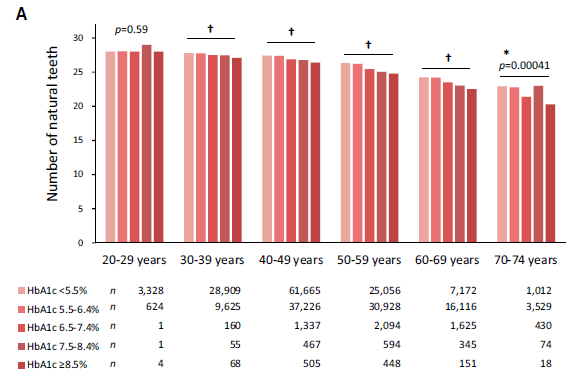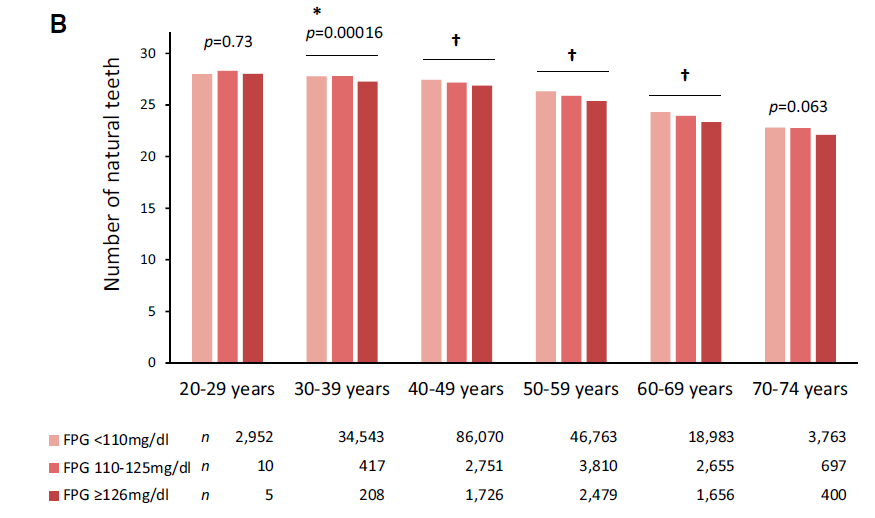- In the largest study of its kind, 233,567 individuals’ insurance claims & check up data was analyzed to assess the relationship between glycemic control and natural tooth retention by age group
- The collaborative research with Shiga University of Medical Science and Sunstar also proves that diabetes and smoking impact tooth retention
- This Japanese study strongly suggests that the importance of glycemic control, especially for people with diabetes or prediabetes, and the role of good oral health care in tooth loss prevention
The largest ever research study into tooth loss and glycemic control in a general population has found compelling evidence that people aged over 30 with higher HbA1c levels and elevated fasting blood glucose levels (FPG) have fewer natural teeth remaining. People at risk are being advised to take steps to better manage their glycemic levels and take steps to improve their oral care, including through smoking cessation.
The cross-sectional study of 233,567 individuals aged 20-70 years old was co-ordinated by Professor Hiroshi Maegawa and Associate Professor Katsutaro Morino of Shiga University of Medical Science, Japan, in collaboration with international oral healthcare company, Sunstar to explore the relationship between glycemic control, tooth retention and age group. It also found that participants with impaired fasting glucose were already at risk of fewer teeth between 40 and 69 years old than those with normal FPG, and that the risk of tooth loss is further increased due to a combination of high blood glucose levels and smoking.
Published in Diabetology International, the Glycemic control and number of natural teeth: analysis of cross-sectional Japanese employment-based dental insurance claims and medical check-up data study,* emphasises the importance of glycemic control and oral care to protect against tooth loss. In particular, this means that anyone diagnosed with diabetes or prediabetes should aim to improve their glycemic control and undergo a dental check-up, while anyone with high blood sugar levels should look to preventative oral care to protect against future tooth loss.
Based on medical examinations and information from health insurance claims between 2015-16, participants were assigned to five groups based on their HbA1c and three groups according to their FPG and then the number of natural teeth were compared. From an original 706,150 participants, ultimately 233,567 individuals were analyzed. The exclusion criteria included missing data around dental attendance or dental data, absence of HbA1c or smoking data or because patients were less than 20 years old.
Patients were categorized according to two glycemic control parameters: HbA1c < 5.5%, 5.5–6.4%, 6.5–7.4%,7.5–8.4%, or ≥ 8.5% [19]; and FPG < 110 mg, 110–125 mg/dl, or ≥ 126 mg/dl in each 10-year age group, while the FPG categories were set with reference to the WHO’s criteria for impaired fasting glucose.
No large studies had previously examined whether there is a continuous relationship of poorer glycemic control and fewer natural teeth and the age at which this relationship appears. These findings prove that glycemic control is strongly associated with the number of natural teeth in a real world setting.
Although cross-sectional design has a limit on establishing a causal relationship, the data strongly supports the previous longitudinal and interventional study and suggests the importance of glycemic control, stopping smoking and appropriate oral care to protect anyone with impaired fasting glucose or diabetes against tooth loss from a young age.
Key research results
1. Remaining number of teeth for each glycemic control level in each age group
A continuous relationship was shown in which the number of teeth decreased in the group with higher HbA1c and fasting blood glucose levels in each age group over 30s (Figs. 1 and 2). In the 40s and 60s, not only the diabetic type (fasting blood glucose level; 126 mg / dl or more) but also the prediabetic group (impaired fasting blood glucose type; 110-125 mg / dl) are compared with the normoglycemic group. It was shown that the number of teeth was small.


2. Risk of tooth loss in middle age due to a combination of hyperglycemia and smoking conditions
In middle age (40-59 years old), non-smokers had more teeth than smokers and there is a high risk that the number of teeth will be less than 24. In addition, it was shown that the risk was even higher in the group where both conditions overlap (hyperglycemia + smoking, prediabetic group + smoking, diabetic type + smoking) (Figs. 3 and 4).

While the study also shows that stopping smoking is key to prevent tooth loss in both non-diabetic and diabetics.
3. Glycemic control and retention rate by tooth site
In another study using the same database, the high HbA1c group, which corresponds to HbA1c ≥ 7.0%, showed lower retention rate in many tooth sites, especially in molars.
*Glycemic control and number of natural teeth: analysis of cross-sectional Japanese employment-based dental insurance claims and medical check-up data; Kayo Harada, Katsutaro Morino, Miki Ishikawa, Itsuko Miyazawa, Takako Yasuda, Mayu Hayashi, Atsushi Ishikado, Hiroshi Maegawa: Diabetology International DOI: https://doi.org/10.1007/s13340-021-00533-2
About Diabetes and Oral Health research in Sunstar Group
Sunstar provides oral care products, cosmetics and health foods with the motto “Always serve to improve people’s health and lifestyle”. Sunstar was amongst the first to focus on the relationship between diabetes and periodontal disease, and have been engaged in research, new product development, and awareness-raising activities in collaboration with universities and medical institutions in Japan and overseas. It aims to continue to contribute to extending the healthy life expectancy of people by providing information, services, and products that contribute to general health while starting from oral health.
Stay Relevant With Endodontic Practice US
Join our email list for CE courses and webinars, articles and more..


